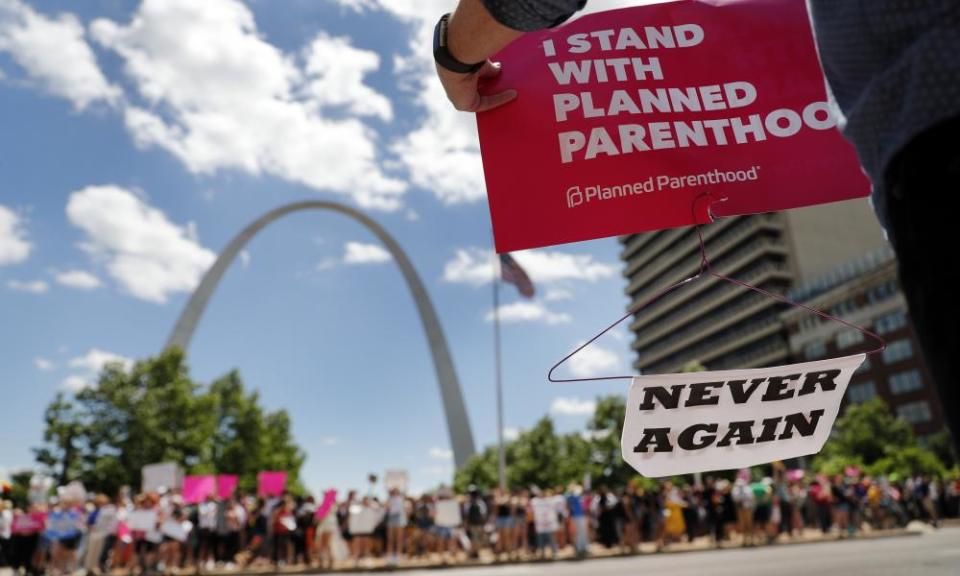Trump abortion ‘gag rule’ leaves poor patients ‘with nowhere to go’ in US

Last year alone, 37,000 low-income patients in Utah received subsidized family planning under Title X, the federal program which distributes grants to clinics.
But as of Monday, when Planned Parenthood withdrew from the longstanding scheme over new Trump administration rule banning clinics from referring patients for abortions, the US non-profit’s Utah branch must now look elsewhere for the $2m annual grant it used to depend on to provide essential services like birth control, STD and breast and cervical cancer tests to poor women.
Related: Female Democrats rally around Planned Parenthood amid abortion rule dispute
“We’re doing all that we can as a team, as a staff, as an organization to try to do what we can to lessen the impact on patients, but the truth is that it harms patients,” said Heather Stringfellow, vice-president of public policy for Planned Parenthood Association of Utah.
“The fact that the Trump administration has put this gag rule in place has forced providers that use best medical practice to guide their care out of the program. The impact is on patients. It’s essentially potentially leaving our patients with nowhere to go.”
For 35 years Planned Parenthood has been the sole Title X provider in Utah, which has an overall annual budget of over $10m. Stringfellow said they have been preparing by diversifying funding streams and are doing their best to maintain services, but that the funding loss will still have a big impact on patients.
Planned Parenthood, which has over 600 health centers across the US, treats 40% of all recipients of Title X, which was founded in 1970. But the organization, which receives an estimated $60m a year from the scheme, decided to pull out after the introduction of what it calls a “gag rule”.

Announcing the decision, the acting Planned Parenthood president and CEO, Alexis McGill Johnson, urged Congress to pass a spending bill to reverse the rule, saying: “People’s lives depend on it.”
While Planned Parenthood has received support from reproductive rights groups, several Democratic presidential candidates and some state governments, clinics and patients across America are still grappling to understand what the new circumstances will mean for their healthcare services.
Impact is expected to vary greatly from state to state. In places such as Vermont, where the state has agreed to step in to fill any funding gaps, or Maryland, which earlier this year became the first state to opt out of Title X in favour of state funding, services are expected to continue as normal. But in others, such as Minnesota, where Planned Parenthood runs 90% of Title X services, or Utah, where it runs 100%, the future of these services is less certain.
Erica Sackin, Planned Parenthood’s senior director of communications, said: “In the United States we already see women having to drive impossible distances to access abortion, what this gag rule means is that women may start to have to drive hundreds of miles just to access an IUD.”
While she said the organization’s “doors are open” and that they are committed to keeping services accessible to all patients, in some states patients will not have many other options.
“And so what that means practically is that, yes, if patients are unable to go to Planned Parenthood for care, the other health centers will likely be flooded and that there will be longer wait times and you’ll see people delaying care or having to go without care,” said Sackin.
They have not ruled out clinic closures. “We’re still figuring out what this means across the country, and we’re doing everything we can to make sure that healthcare doesn’t suffer. It may mean health centres have to close,” she said.
Dr Diane Horvath, a fellow at Physicians for Reproductive Health and medical director at Whole Women’s Health of Baltimore, said that although her own clinic will not be affected, the rule change will “disproportionately impact” the young, LGBTQIA people, the poor, people of color and those living in rural communities.
“They will be forced to travel farther for care, endure longer waits, accept limited or lower-quality care, or be left without an accessible clinic entirely,” she added.
Patients are engaged and angry, said Lucy Leriche, vice-president of Vermont public affairs for Planned Parenthood of Northern New England, who has seen an influx of patients offering themselves up as volunteers.
“People are pretty outraged that the Trump-Pence administration is essentially attacking and trying to take away contraceptive care, contraception and basic healthcare from people with low incomes,” she added.
In New York, where Planned Parenthood centers serve just over half of the state’s Title X patients, the organization is working closely with the state which it hopes will provide additional funding.
Merle Hoffman, founder, president and CEO of Choices in Jamaica, Queens, said that while she does not expect funding losses to affect her patients from New York, she anticipates the number of people traveling from further afield for treatment to rise.
“I would expect to see women from other states where that loss of funding would send them here,” she said.
Andrea Miller, president of National Institute for Reproductive Health (NIRH) and NIRH Action Fund, warned the changes will be felt most acutely in states that have already passed restrictive abortion laws.
The new Title X rule, she said, leaves clinics with few options. “They either have to lie to their patients and not give them information about the full range of options available to them, or they have to potentially close their doors. And those are two impossible positions to be in for any healthcare provider,” she added.
